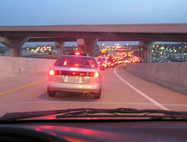High ICC tolls show how expensive new freeways are
Many drivers are experiencing sticker shock at the proposed toll rates for the Intercounty Connector, up to 35 cents a mile during peak periods. The proposed toll structure is more expensive per mile than the turnpikes in neighboring New Jersey and Pennsylvania, and existing tolled portions of I-95 in Maryland. According to the Post, “the next-most expensive would be the Dulles Greenway’s peak toll, which amounts to 28.5 cents a mile. Across the country, highway toll rates typically fall between 3 cents and 25 cents a mile, according to AAA. … About one-quarter [of drivers] are projected to travel between the I-270 and I-95 corridors, facing a potential $5.60 rush-hour toll each way.”
Why will the ICC be so expensive to drive? It’s simple: the ICC is expensive to build, and proponents sold the road as a good deal because tolls would pay for most or all of the cost. But many voters and elected officials who supported the road didn’t realize just how expensive it would be. Others reacted negatively not just to the size of the proposed tolls, but to the fact that driving on it will be tolled at all.
Those who opposed the ICC from the start are getting to say a bit of “I told you so.” According to the Gazette, former Environmental Defense transportation director Michael Replogle, who fought the ICC all along, said that the opponents knew the tolls would be high. Replogle also pointed out that even with high tolls, Maryland will be spending scarce general transportation funds on the ICC at the expense of other needs elsewhere.
The ICC’s subsidy will go way, way up if pushback from residents or elected officials succeeds in reducing the tolls. Montgomery Councilmember Phil Andrews opposed the road in the first place, but is now trying to lower the tolls. Paying for much of the road’s cost with tolls was the plan from the start. Most people just didn’t realize how expensive it really is.
Much of the general public tends to see roads as “free” and transit as “fare-based.” Fundamental road costs such as the gas tax, supplemental general government fund appropriations (the gas tax hasn’t completely covered road-related costs for years), and the opportunity costs of car-dependent land uses are hidden from view on a day-to-day basis. The costs of ICC tolls will start to change that perception. There is nothing “free” about the ICC. The hidden costs aren’t free. The up-front tolls won’t be free, either. Future elected officials will be far more hesitant to build new highways because the continued increase in construction costs will make them more likely to require tolls. They won’t want to be known as someone who is in favor of high highway tolls.
The public’s ICC-related sticker shock could be a turning point in their perception of “free” roads. Rather than having a mental image of themselves driving on a traffic-free road as fast as possible with the wind in their hair, they will instead envision themselves paying tolls. A $6.15 one-way rush hour toll works out to over $2,900 a year for a two-way daily commute. Most of the public will not make the explicit connection that the tolls are in lieu of higher taxes. The money for the debt service related to building the road has to come from somewhere. Some will drive and pay. Some will drive and take another route. Some will switch to transit (if possible). Some will switch jobs. Regardless, the experience of the $12.30 per day toll will never leave the public’s consciousness.
The era of where we could just throw up highways just for motorist convenience is over. It is a shame that it will take the extremely expensive, failed legacy of the ICC in order for this reality to seep into the consciousness of the general public — if it does at all. However, it is better late than never, and there is still time to act to prevent a $4.6 billion repeat on I-270. Neighboring jurisdictions in our region should learn from Maryland’s mistakes with the ICC.
Maryland is holding a series of meetings on the ICC tolls starting tonight. You can also comment on the tolls via the Web site.

